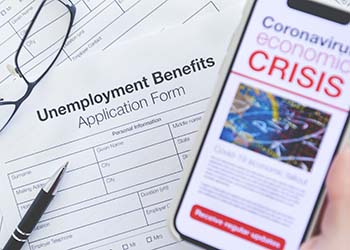New Study in the Journal of Labor Economics Shows how Workers Respond to More Generous Unemployment Insurance Benefits
- By:
- Category:

Los Angeles, CA – April 11, 2024 – The April issue of the Journal of Labor Economics contains a new study from the nonpartisan California Policy Lab that examines the link between unemployment insurance (UI) benefit amounts and how long people remain out of work. Unlike most previous research, this new study looks at how that relationship changes during recessions — including during the COVID-19 pandemic.
“People usually spend more time unemployed when their UI benefit amounts increase. A surprising result from our research is that this relationship was very weak during the pandemic even though the benefits were larger and could be claimed for longer,” explains co-author Geoff Schnorr, a postdoctoral scholar at the California Policy Lab. “We think this is because the costs and benefits of returning to work changed dramatically during the pandemic. Other federal stimulus may have meant that unemployed workers were less reliant on income from UI benefits during their time out of work, and the pandemic itself may have made returning to work risky.”
“These findings can help policymakers in future economic downturns,” adds co-author Alex Bell, a postdoctoral scholar at the California Policy Lab. “Policymakers will continue to face decisions about how to balance the amount and duration of UI benefits. Our results show that unemployed workers do not respond more to unemployment benefits in recessions, but benefit from higher coverage when the duration of unemployment benefits is extended.”
The research team used unemployment benefit records from 2002 to 2020 to estimate the impact higher benefit amounts have on how long people claim UI benefits, and to see if this relationship changed during recent recessions.
The California Policy Lab website has additional background on the research study.
Key Findings:
1) The effect of UI benefit generosity on claimants’ behavior at any given point in time while they are claiming UI benefits does not vary with the business cycle. When weekly benefit amounts are higher, claimants are less likely to choose to stop receiving the benefits at any point in their unemployment spell, but this effect does not vary with labor market conditions.
2) Although the effect of UI benefits on survival rates does not vary over the business cycle, the relationship between the amount of UI benefits and how long somebody continues receiving UI benefits is stronger during recessions. This is due to other changes in the UI program that occur during recessions, namely extensions to the maximum number of weeks claimants are allowed to claim UI. During a recession, claimants who might have otherwise exhausted their UI benefits can continue to claim benefits for much longer because of these extensions. While it may appear that the workers are responding differently to higher benefits during a recession, this is actually being driven by the fact that workers can claim benefits longer because of the extensions.
3) During the first year of the pandemic, the relationship between UI benefit amounts and how long people stay unemployed was weaker than at any point in the previous 20 years. The researchers calculated that a 1% increase in weekly UI benefit amounts during this time only led to a .3% increase in 10-week survival rates – a 33% decrease from pre-pandemic estimates. This weakened relationship was not driven by the observed changes in who was claiming UI benefits. Instead, it appears to have been a result of other unique factors of the pandemic — including federal stimulus payments and health risks faced in some workplaces.
###
The California Policy Lab generates research insights for government impact. Through hands-on partnerships with government agencies, CPL performs rigorous research across issue silos and builds the data infrastructure necessary to improve programs and policies that millions of Californians rely on every day.
